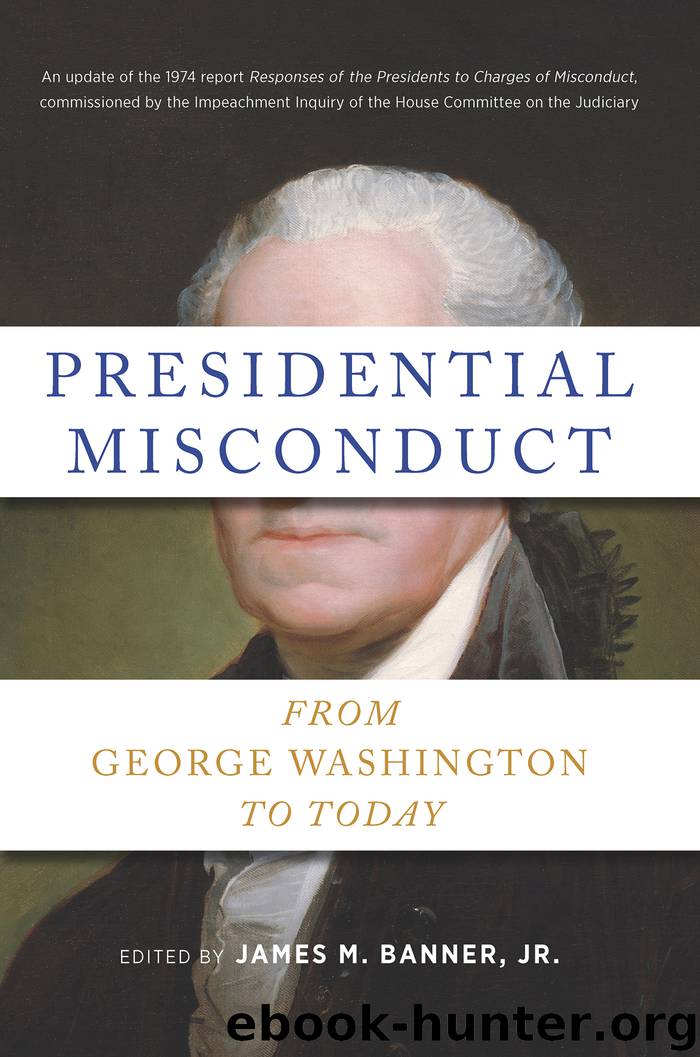Presidential Misconduct by Unknown

Author:Unknown
Language: eng
Format: epub
Publisher: The New Press
Published: 2019-03-06T16:00:00+00:00
WARREN G. HARDING 1921–1923
Robert P. Ingalls
Historians have long regarded Warren G. Harding’s administration as the most corrupt in the twentieth century.1 Ultimately, three of the President’s appointees, including a cabinet officer, went to jail. His attorney general was tried twice by juries that failed to reach a verdict after the defendant refused to testify. The Attorney General’s closest friend and confidant committed suicide, as did the chief counsel of the Veterans’ Bureau.
In addition to these instances of corruption, the Harding administration was troubled by allegations of government by crony. Harding claimed that in selecting his cabinet he sought the “best minds,” which was undoubtedly the case in the choice of men such as Charles Evans Hughes, Herbert Hoover, and Henry Wallace. But the cabinet also included Harry M. Daugherty, whose background made him an object of suspicion as attorney general. Daugherty, a lawyer originally from Washington Court House, Ohio, had served briefly in the state legislature during the 1890s, but his chief association with politics was through his activities as a lobbyist and his long-time friendship with Harding. The lawyer had first met Harding around the turn of the century at a Republican rally, and according to Daugherty, he immediately thought to himself, “What a President he’d make.”2 The relationship between the two deepened as Harding moved up in Ohio politics and Daugherty boosted him for the presidency. After serving as Harding’s campaign manager in 1920, Daugherty became attorney general.
Below the cabinet level, Harding appointed other friends to government posts. Dr. Charles E. Sawyer from Harding’s home town of Marion became a brigadier general and White House physician. Ed Scobey, a one-time county sheriff and old friend, was selected as director of the Mint. Harding picked his brother-in-law, Reverend Heber H. Votaw, for superintendent of federal prisons after removing the position from the civil service lists. Daniel Crissinger, a Marion lawyer with little banking experience, was named controller of currency and, subsequently, governor of the Federal Reserve Board. At the time these appointments attracted little attention, but they were later cited as evidence of Harding’s questionable standards, despite the fact that most of his friends in government were never implicated in any wrongdoing.
Although the Harding administration produced some of the worst examples of corruption in the history of the federal government, much of the evidence of misconduct did not surface until after Harding died on August 2, 1923. Therefore, this section treats only Harding’s responses to charges aired before August, 1923, and the discussion of the Coolidge administration examines the reaction of Coolidge to subsequent allegations of official misconduct which reportedly occurred under Harding.
Harry M. Daugherty and Jesse W. Smith
In 1922 critics of Attorney General Harry M. Daugherty tried unsuccessfully to impeach him. Daugherty first came under attack in the spring of 1922 because of his failure to pursue war fraud cases brought against companies that had allegedly engaged in profiteering during World War I. Congressional criticism increased after the Attorney General obtained a sweeping injunction against railway strikers in September, 1922.
Download
This site does not store any files on its server. We only index and link to content provided by other sites. Please contact the content providers to delete copyright contents if any and email us, we'll remove relevant links or contents immediately.
Cecilia; Or, Memoirs of an Heiress — Volume 2 by Fanny Burney(31868)
Cecilia; Or, Memoirs of an Heiress — Volume 3 by Fanny Burney(31852)
Fanny Burney by Claire Harman(26526)
We're Going to Need More Wine by Gabrielle Union(18967)
Plagued by Fire by Paul Hendrickson(17329)
All the Missing Girls by Megan Miranda(15562)
Cat's cradle by Kurt Vonnegut(15179)
Bombshells: Glamour Girls of a Lifetime by Sullivan Steve(13972)
Leonardo da Vinci by Walter Isaacson(13179)
For the Love of Europe by Rick Steves(12927)
4 3 2 1: A Novel by Paul Auster(12281)
Adultolescence by Gabbie Hanna(8856)
The remains of the day by Kazuo Ishiguro(8817)
Note to Self by Connor Franta(7620)
Diary of a Player by Brad Paisley(7487)
Giovanni's Room by James Baldwin(7188)
What Does This Button Do? by Bruce Dickinson(6133)
Ego Is the Enemy by Ryan Holiday(5292)
Born a Crime by Trevor Noah(5292)
